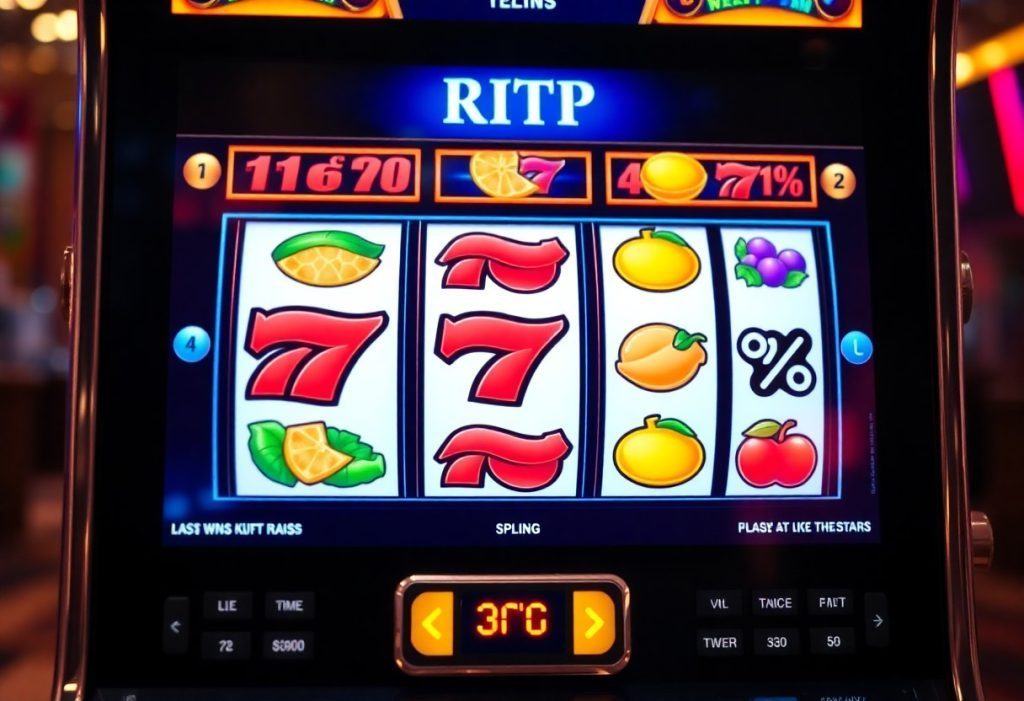
RTP, or Return to Player, is a key metric that players should understand when engaging with online slots. It indicates the percentage of wagered money that a slot machine is programmed to return to players over time, which can be anywhere from 85% to 98%. This figure plays a significant role in determining the potential profitability and overall experience of the game. He, she, and they should be aware that while a higher RTP suggests better long-term returns, it does not guarantee short-term winnings, making it imperative for players to make informed decisions about their gameplay.
Key Takeaways:
- RTP, or Return to Player, is a percentage that indicates the amount of wagered money a slot machine is expected to pay back to players over time, typically ranging from 85% to 98%.
- The RTP value is calculated over a long period and numerous spins, meaning individual sessions can vary greatly, and players may experience lower or higher returns in the short term.
- Players can use RTP as a guide for choosing slots, with higher RTP percentages generally suggesting better long-term payouts, making it a valuable factor in game selection.
What is RTP?
To understand RTP, or Return to Player, one must recognize it as a key metric that indicates the percentage of wagered money that a slot machine is programmed to return to players over time. This figure is invaluable for players seeking to maximize their gaming experience while also being aware of their potential losses.
Definition of RTP
About RTP, it is defined as the statistical measure that reflects the expected return a player can anticipate from a particular game. For instance, a slot with an RTP of 96% suggests that over a significant duration, it will return $96 for every $100 wagered, although actual results may vary widely in the short term.
Importance in Online Slots
Above all, RTP plays a significant role in online slots as it helps players assess the fairness and potential profitability of various games. By comparing RTP percentages, players can make informed choices regarding which slots to play, impacting their overall gaming experience.
A high RTP not only indicates a greater likelihood of receiving back a portion of their wagers but also contributes to player satisfaction and retention in gaming environments. Additionally, casinos often promote games with attractive RTPs to entice players, showcasing a commitment to fair play. Conversely, games with low RTPs may lead to frustration, as players might lose their funds more rapidly. Ultimately, understanding RTP empowers players to make strategic gaming decisions that align with their preferences and risk tolerance.
How RTP is Calculated
Clearly, the Return to Player (RTP) percentage represents the average amount a player can expect to return from their wagers over time. This value is determined by analyzing vast amounts of data collected from actual gameplay and statistical models. The RTP is expressed as a percentage and indicates the portion of total bets returned to players.
Methodology of Calculation
Among the various methods for calculating RTP, one common approach involves simulating thousands or even millions of spins to gather data on the payout distribution. This statistical analysis allows developers to establish average payouts realistically, leading to the final RTP percentage. Variations in methodology can occur based on game designs and payout structures.
Factors Affecting RTP
The performance of RTP can be influenced by several factors, including:
- Game design
- Volatility
- Payout structure
- Time of play
The different aspects of the game can affect how likely players are to win. Recognizing these characteristics can help players make more informed choices about which slots to play.
To enhance understanding of RTP, it’s important to consider how various factors shape the gameplay experience. These aspects include:
- Game design dictates the overall playability and player engagement.
- Volatility impacts the frequency and size of wins.
- Payout structure establishes how winnings are distributed to players.
- Time of play can alter player outcomes, especially in high-stakes settings.
Recognizing the interplay between these factors helps players navigate the complexities of online slots effectively.
RTP vs. Volatility
All online slots players should understand the difference between RTP (Return to Player) and volatility. While RTP indicates the percentage of wagered money that returns to players over time, volatility describes the level of risk involved in a slot game. Together, they provide valuable insights into gaming experiences, but they serve distinct purposes.
Understanding Volatility
For players, understanding volatility is vital for making informed bets. Low volatility slots offer frequent, smaller payouts, while high volatility slots provide larger wins but less frequently. Players must align their betting strategies with their risk tolerance to enhance their overall experience.
How They Interact
Against popular belief, RTP and volatility are interconnected elements that influence a player’s experience. While a game with a high RTP ensures better long-term returns, its volatility can determine how often players make actual wins. A game can have a high RTP but low payouts if its volatility is high, meaning players may see little reward in the short term.
To fully grasp their interaction, players should analyze both factors when choosing a slot game. A high RTP combined with low volatility might yield consistent wins, enhancing player satisfaction. However, a player opting for a high volatility game could enjoy occasional large payouts despite the risk of lengthy dry spells. They should assess their own risk appetite and select games that balance these parameters in a way that suits their playing style.
The Role of RTP in Game Selection
Your choice of online slot games can significantly affect your overall experience. By understanding Return to Player (RTP), players can make informed decisions and select games that best suit their gaming preferences and potential payout outcomes. RTP serves as a guiding metric, allowing them to weigh options across various titles and ultimately choosing games with better odds for winning.
Choosing Games with High RTP
One key strategy in online slots selection is to focus on games that feature a high RTP percentage. These games typically return a larger portion of wagered funds back to players over time, thus enhancing their chances for a favorable return on investment. High RTP games often attract seasoned players looking for better odds and more consistent wins.
Impact on Player Strategy
An understanding of RTP can significantly influence a player’s strategy in choosing games. Players might opt for titles that feature higher RTP percentages, believing they provide greater long-term value and potential success. By being mindful of RTP, players create a strategy that maximizes their gaming funds and enhances enjoyment.
Further, by focusing on RTP when selecting games, players can improve their playing strategy and make more educated bets. This approach allows them to prioritize games that not only entertain but also promise better payout potentials. It is important to recognize that while high RTP games can lead to a greater likelihood of returns, they do not guarantee winnings in every session. Strategy, bankroll management, and game volatility also play significant roles. Therefore, players should combine their knowledge of RTP with a solid understanding of overall game mechanics for a well-rounded experience.
Misconceptions About RTP
Many players hold misconceptions regarding the Return to Player (RTP) percentage in online slots, leading to misunderstandings about their gambling experience. These misconceptions can impact their expectations and gameplay strategies, often resulting in frustration or poor decisions.
Common Myths
The belief that RTP is a guarantee of winnings is prevalent among players. They often assume that higher RTP percentages ensure consistent payouts, while in reality, RTP reflects long-term averages over a significant number of spins rather than short-term outcomes.
Clarifying Misunderstandings
Any confusion surrounding RTP can deter players from making informed decisions. Many do not realize that RTP is calculated over extensive gameplay and does not influence individual spin results.
Consequently, players should understand that a higher RTP does not mean frequent wins; instead, it signifies a better chance of returning a portion of the wagered amount over time. Ignoring this distinction can lead to misplaced optimism or unfair dissatisfaction with outcomes. Furthermore, it is important for players to grasp that each spin is independent, and the house edge remains constant, regardless of previous game results. By educating themselves, players can approach online slots with a clearer mindset, avoiding the pitfalls of misunderstanding RTP.
Future of RTP in Online Gaming
For online gaming enthusiasts, the future of Return to Player (RTP) is promising, with advancements in technology and player preferences shaping the landscape. Developers are focusing on creating more engaging experiences, which could lead to higher RTP percentages, improved transparency, and enhanced player trust. As the industry evolves, RTP may play a vital role in attracting and retaining players.
Trends in RTP Development
Online slots developers are adopting innovative approaches to RTP, incorporating player feedback to enhance gameplay experiences. Gamification elements, personalized rewards, and dynamic RTP adjustments are becoming increasingly popular. They aim to keep players engaged while offering competitive RTPs, which may lead to greater player satisfaction and loyalty.
Potential Changes in Regulations
At the regulatory level, changes may impact RTP standards in online gaming. Authorities are increasingly focusing on transparency and fairness, demanding that operators meet stringent requirements regarding the RTP rates. This could lead to more consistent RTP reporting and possibly even standardized minimum RTP percentages across jurisdictions.
Future regulations may aim to ensure that players have access to regular audits and verified payout percentages, enhancing trust in online slots. They may also address the growing concerns around responsible gaming practices and operator accountability. These potential changes could create a safer environment, pushing operators to prioritize fair gaming while advocating for better transparency in RTP reporting. Overall, the evolution of regulations could significantly influence how RTP is approached, ensuring it aligns with player interests and industry standards.
Final Words
Ultimately, understanding how RTP works in online slots can empower players to make informed decisions when choosing games. They can recognize that RTP represents the expected return of their wagers over time. He or she should take into account that while the RTP is a useful indicator, individual results may vary significantly in the short term due to the inherent randomness of slot machines. By selecting games with higher RTP percentages, players may enhance their overall gaming experiences and potentially improve their chances of success.






